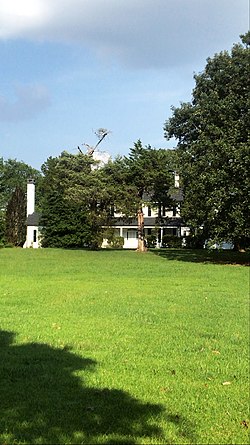History
The Patterson Plantation was first listed in a 1770 Collet Map as "I. Paterson", at the time it was owned by a planter named John Patterson, who built a cabin on the site. [1] The family also operated a mill, known as Patterson's Mill, along New Hope Creek in what is now Duke Forest. [1] The land later passed to Patterson's son, John Tapley Patterson. [1] Upon his death, it passed to his son, Mann Patterson. [1] Construction on the large Federal-style house began in 1834, shortly before the death of Patterson. [1] His second wife Mary Cabe Patterson, who had inherited the 2,200-acre plantation, later completed the building. [1] It was built at the intersection of Erwin and Whitfield Roads, less than a mile from Mt. Moriah Baptist Church. [1] The Patterson's two sons, Mann and Robert, also lived at the farm. [1] Two house slaves, named Matthew and Phebe, were listed as part of the household in 1870. [1]
The plantation also includes a family cemetery, located further down Erwin Road, which includes 27 marked graves and 5 unmarked graves. [2]
In the 1950s, the plantation was under the ownership of Charlie and Josie Henderson Humphries, who had inherited it from family members. [1] The Humphries later moved to Hope Valley Country Club, and members of the Henderson family came to live on the property, building a house across the street in the 1980s. [1]
The plantation was later purchased by David Dickson and renamed Holly Rock Farm. [1]
This page is based on this
Wikipedia article Text is available under the
CC BY-SA 4.0 license; additional terms may apply.
Images, videos and audio are available under their respective licenses.

